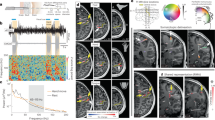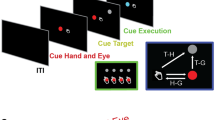Abstract
The anterior part of the parietal association area in the cerebral cortex of primates has been implicated in the integration of somatosensory signals1,2, which generate neural images of body parts and apposed objects and provide signals for sensorial guidance of movements3,4,5,6. Here we show that this area is active in primates performing numerically based behavioural tasks. We required monkeys to select and perform movement A five times, switch to movement B for five repetitions, and return to movement A, in a cyclical fashion. Cellular activity in the superior parietal lobule reflected the number of self-movement executions. For the most part, the number-selective activity was also specific for the type of movement. This type of numerical representation of self-action was seen less often in the inferior parietal lobule, and rarely in the primary somatosensory cortex. Such activity in the superior parietal lobule is useful for processing numerical information, which is necessary to provide a foundation for the forthcoming motor selection.
This is a preview of subscription content, access via your institution
Access options
Subscribe to this journal
Receive 51 print issues and online access
$199.00 per year
only $3.90 per issue
Buy this article
- Purchase on Springer Link
- Instant access to full article PDF
Prices may be subject to local taxes which are calculated during checkout



Similar content being viewed by others
References
Sakata, H., Takaoka, Y., Kawarasaki, A. & Shibutani, H. Somatosensory properties of neurons in the superior parietal cortex (area 5) of the rhesus monkey. Brain Res. 64, 85–102 (1973).
Mountcastle, V. B. in Handbook of Physiology, Sensory Processes Vol. 3 (eds Brookhart, J. M. et al.) 789–878 (American Physiol. Soc., Bethesda, 1984).
Mountcastle, V. B., Lynch, J. C., Georgopoulos, A., Sakata, H. & Acuna, C. Posterior parietal association cortex of the monkey: command functions for operations within extrapersonal space. J. Neurophysiol. 38, 871–908 (1975).
Seal, J., Gross, C. & Bioulac, B. Activity of neurons in area 5 during a simple arm movement in monkeys before and after deafferentation of the trained limb. Brain Res. 250, 229–243 (1982).
Crammond, D. J. & Kalaska, J. F. Neuronal activity in primate cortex area 5 varies with intended movement direction during an instructed-delay period. Exp. Brain Res. 76, 458–462 (1989).
Burbaud, P., Doegle, C., Gross, C. & Bioulac, B. A quantitative study of neuronal discharge in areas 5, 2, and 4 of the monkey during fast arm movements. J. Neurophysiol. 66, 429–443 (1991).
Balint, R. Seelenlahmung des “Schauens,” optische Ataxie, raumliche Störung der Aufmerksamkeit. Monatsschr. Psychiatr. Neurol. 25, 51–81 (1909).
Ramachandran, V. S. & Hirstein, W. The perception of phantom limbs. Brain 121, 1603–1630 (1998).
Iriki, A., Tanaka, M. & Iwamura, Y. Coding of modified body schema during tool use by macaque postcentral neurones. NeuroReport 7, 2325–2330 (1996).
Graziano, M. S. A., Cooke, D. F. & Taylor, C. S. R. Coding the location of the arm by sight. Science 290, 1782–1786 (2000).
Jones, E. G., Coulter, J. D. & Hendry, S. H. C. Intracortical connectivity of architectonic fields in the somatosensory, motor and parietal cortex of monkeys. J. Comp. Neurol. 181, 291–347 (1978).
Dehaene, S., Dehaene-Lambertz, G. & Cohen, L. Abstract representations of numbers in the animal and human brain. Trends Neurosci. 21, 355–361 (1998).
Washburn, D. A. & Rumbaugh, D. M. Ordinal judgments of numerical symbols by macaques (Macaca mulatta). Psychol. Sci. 2, 190–193 (1991).
Hauser, M. D., MacNeilage, P. & Ware, M. Numerical representations in primates. Proc. Natl Acad. Sci USA 93, 1514–1517 (1996).
Boysen, S. T. & Capaldi, E. J. The Development of Numerical Competence: Animal and Human Models (Erlbaum, Mahwah, NJ, 1993).
Matsuzawa, T. Use of numbers by a chimpanzee. Nature 315, 57–59 (1985).
Dehaene, S. & Changeux, J. P. Development of elementary numerical abilities: A neuronal model. J. Cogn. Neurosci. 5, 390–407 (1993).
Brannon, E. M. & Terrace, H. S. Ordering of the numerosities 1 to 9 by monkeys. Science 282, 746–749 (1998).
Orlov, T., Yakovlev, V., Hochstein, S. & Zohary, E. Macaque monkeys categorize images by their ordinal number. Nature 404, 77–80 (2000).
Chochon, F., Cohen, L., Moortele, P. F. & Dehaene, S. Differential contributions of the left and right inferior parietal lobules to number processing. J. Cogn. Neurosci. 11, 617–630 (1999).
Shima, K. & Tanji, J. Neuronal activity in the supplementary and presupplementary motor areas for temporal organization of multiple movements. J. Neurophysiol. 84, 2148–2160 (2000).
Pons, T. P., Garraghty, P. E., Cusick, C. G. & Kaas, J. H. The somatotopic organization of area 2 in macaque monkeys. J. Comp. Neurol. 241, 445–466 (1985).
Lewis, J. W., Burton, H. & Van Essen, D. C. Anatomical evidence for the posterior boundary of area 2 in the macaque monkey. Somatosens. Motor Res. 16, 382–390 (1999).
Acknowledgements
We thank M. Kurama and Y. Takahashi for technical help. This work was supported by a Grant-in-Aid for Scientific Research on Priority Areas, Advanced Brain Science Project, from the Ministry of Education, Culture, Sports, Science and Technology, Japan, and by the Japan Science and Technology Corporation.
Author information
Authors and Affiliations
Corresponding author
Ethics declarations
Competing interests
The authors declare no competing financial interests.
Rights and permissions
About this article
Cite this article
Sawamura, H., Shima, K. & Tanji, J. Numerical representation for action in the parietal cortex of the monkey. Nature 415, 918–922 (2002). https://doi.org/10.1038/415918a
Received:
Accepted:
Issue Date:
DOI: https://doi.org/10.1038/415918a
This article is cited by
-
Number selective sensorimotor neurons in the crow translate perceived numerosity into number of actions
Nature Communications (2022)
-
The link between number and action in human infants
Scientific Reports (2022)
-
Topographic numerosity maps cover subitizing and estimation ranges
Nature Communications (2021)
-
Topographic maps representing haptic numerosity reveals distinct sensory representations in supramodal networks
Nature Communications (2021)
-
Action control, forward models and expected rewards: representations in reinforcement learning
Synthese (2021)
Comments
By submitting a comment you agree to abide by our Terms and Community Guidelines. If you find something abusive or that does not comply with our terms or guidelines please flag it as inappropriate.



